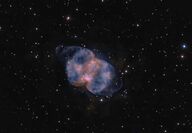Sorted by date Results 1 - 17 of 17

If, after sundown this month, you were to look up in the northeastern sky, you would get a great view of Boötes, the Herdsman. Visible to observers in the Northern Hemisphere, this constellation is bordered by its celestial neighbors Canes Venatici and Coma Berenices to the west, and Corona Borealis and Serpens Caput to the east. You can easily find Boötes by first locating the Big Dipper and then extending an arc along the Dipper’s handle until reaching Arcturus, t... Full story

If you look up into a cloudless sky after sundown this month, you will have a great view of Auriga, the Charioteer, located nearly overhead. Visible to observers in the Northern Hemisphere, this constellation is bordered by its celestial neighbors Camelopardalis, Gemini, Lynx, Perseus, and Taurus. While Auriga isn’t the biggest piece of real estate on the celestial sphere, it ranks 21st largest among the 88 constellations. Identifying Auriga is not hard since many of its b... Full story

During late fall and early winter, observers in the northern hemisphere have an opportunity to see the 24th largest constellation by area: Perseus the Hero. To locate it, draw an imaginary line from the circumpolar constellation of Cassiopeia (the “W”) to the zodiacal stellar grouping known as Taurus. Except for the two end points, the entire length of this line resides within Perseus. Look for it overhead during the evening hours this month. Perseus contains eight stars wit... Full story

With autumn’s arrival, temperatures have begun to cool as the sun sinks ever lower in the sky as the season progresses. We’ve even had a touch of much-needed rain. The shortening days and lengthening nights will also lead to more opportunities for stargazing. While it is true that the evening constellations are dimmest during this time of year, most of them can still be identified under a clear, moonless sky. One of these is our featured constellation for this month, nam... Full story

By late summer and early fall, a few of the “water” constellations begin to materialize in the southeast at nightfall. First to arrive on the scene are Capricornus the Sea Goat, Delphinus the Dolphin, and Aquarius the Water Carrier. The smallest of the three is Delphinus, our featured constellation for September. Although the size of the celestial dolphin is quite modest, four relatively bright stars form an easily recognizable shape resembling a flattened diamond, which outli... Full story

Gazing skyward on a dark, clear, warm summer evening in Central Oregon, observers will be rewarded by a multitude of celestial treasures. When it comes to peering into individual constellations, none of them have more to offer than Sagittarius, for there are spectacular sights of every sort. Even the center of our galaxy resides here. Sagittarius, the celestial Archer, is the 15th largest constellation in our night sky. Because the sun visits here (in the dead of winter) on it... Full story

There’s nothing more beautiful than a summer night sky in Sisters. While you’re soaking up the spectacular, starry canopy above, keep an eye out for the snake charmer, er… the snake handler… okay, officially known as Ophiuchus (pronounced of-ee-yoo-kuhs), the Serpent Bearer. This sprawling constellation is the 11th largest in the sky, and ranges from 14 degrees above the celestial equator at its northernmost extent to 30 degrees below at its southern border. Whil... Full story
Each year during the month of June, the sun ascends to its northern-most point above Earth’s equator. When this happens, we celebrate the beginning of summer. Take advantage of the warmer evenings to gaze into Central Oregon’s star-studded night sky, for there are wondrous sights to behold. There is a strip of sky, centered on the ecliptic, that passes through twelve constellations. Called the zodiac, this piece of celestial real estate is where the sun, moon, and the solar system’s major planets are always found. One of th... Full story

As the weather begins to warm, with spring just around the corner, March contains an abundance of astronomical offerings. Some of these include the zodiacal light, a four-bodied conjunction, and optimal views of the full supermoon — or is it? But up first is a profile of the early spring constellation of Hydra. Hydra, the Water Serpent, is the largest, occupying an area of 1,303 square degrees, and longest of the 88 modern constellations. Except for its head, this groupi... Full story

The late fall constellation of Aries is a particularly appropriate celestial feature to highlight in a month that takes us from autumn into the winter season. Though Aries (Latin for ram) is not very recognizable as its namesake, this midsize constellation does contain three moderately bright stars, of which Hamal is the most luminous at a magnitude of 2.0. Hamel is officially classified a red giant star and its light has a definite orange hue. It is estimated to be about 3.4... Full story

Generally speaking, constellations in evening autumn skies tend to be dimmer than those on display during the winter, spring, and summer seasons. This rule of thumb does not apply, however, to our featured constellation for October. In October Pegasus, the Flying Horse, is already well up in the eastern sky by about 8 p.m. local time. To find it look for a giant square marked by Scheat, Markab, Algenib and Alpheratz, stars of approximately equal brightness. Alpheratz was... Full story

September is a transition month when it comes to stargazing. The constellations of summer are slowly making their way westward, while those of autumn begin to appear in the eastern sky. And, of course, the longer nights, coupled with still-comfortable temperatures, should provide ideal conditions for taking in the celestial sights. Ascending in the northeast sky after dusk is the prominent W-shaped constellation of Cassiopeia, queen of Ethiopia in legend. Although listed in... Full story

In July the warmer weather and increasingly longer nights combine to make stargazing a perfect activity with which to spend your time. Now, if we could only find a way to start observing earlier in the evening and get to bed at a more reasonable hour, it would be ideal. Of course, doing away with daylight saving time is the obvious solution, but that probably won’t happen anytime soon. One of the most recognizable constellations in the summer sky is Cygnus, the swan. It is t... Full story

Though Auriga, The Charioteer, isn’t the most recognizable constellation in the sky, it is one of the bigger ones. It is the 21st largest constellation in the sky, occupying 657 square degrees of the celestial sphere. This star pattern is well up in the northeastern sky in the early evenings during January, and is nearly overhead at 10 p.m. local time by mid-month. Auriga is bordered by Camelopardalis to the north, Lynx to the east, Taurus and Gemini to the south, and Perseus... Full story

After the Big Dipper, Orion is probably the most recognizable arrangement of star patterns. Its size, comprising 594 square degrees of the sky, and bright stars simply make this constellation nearly unavoidable in an outdoor nighttime setting. It is located in the east southeast at about 8 p.m. local time, climbing higher in the sky as the night progresses. Orion is bordered by Taurus and Eridanus to the west and Monoceros to the east. Orion’s two brightest stars are Rigel, a... Full story

With the arrival of summer just around the corner, it is not unreasonable to expect warmer temperatures and clearer skies to make viewing a parade of upcoming celestial events a pleasant one. True, we get a late start for evening observing because of Daylight Saving Time, but that’s not likely to change until enough people decide to do away with the unnecessary ritual. The Summer Solstice does indeed arrive later this month — on June 21 at 8:54 a.m. PDT to be exact. O... Full story

Throughout the months of January and February the sun has been slowly drifting northward in the sky. At 2:58 p.m. PDT on Wednesday, March 20, it will reach the celestial equator as the season changes from winter to spring in the Northern Hemisphere. The event is known as the vernal equinox and results in roughly equal amounts of daylight and darkness in a 24-hour period. Besides bringing with it the prospect of warmer weather, spring signals changes in the night sky as well, p... Full story